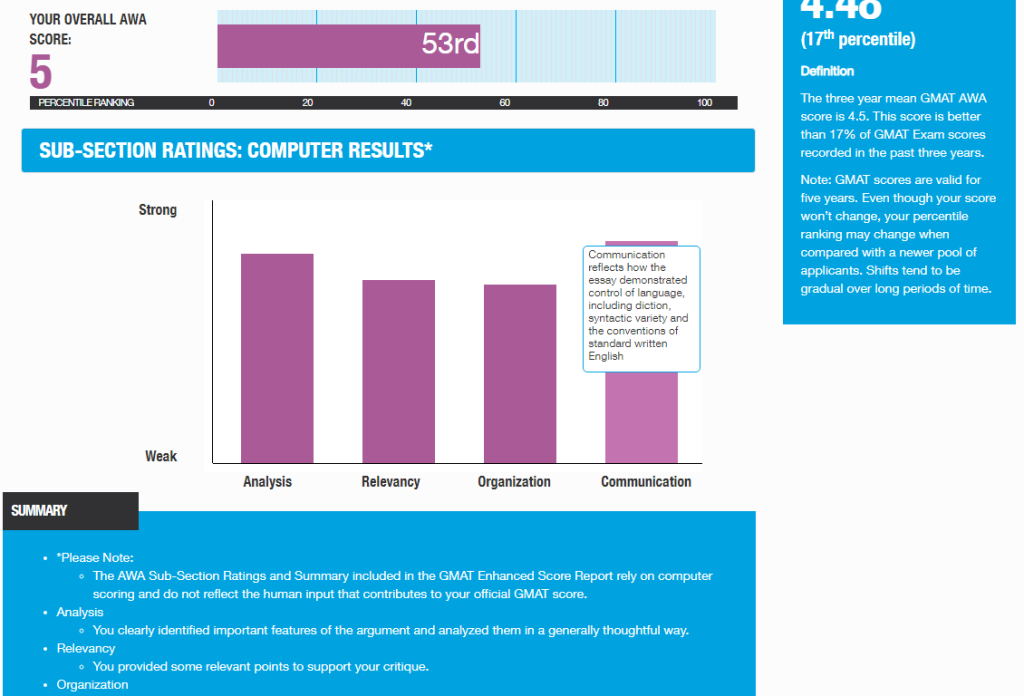

No one (test-takers or business schools) considers it as important as the rest of the test, and it's scored separately from the Quantitative and Verbal parts of the exam. The Analytical Writing Assessment (AWA) is the neglected stepchild of the GMAT. Subscribe to GMAT Hacks via RSS or Email. Reading quality publications such as The Economist or The New Yorker, among others, may help you to familiarize yourself with grammar and varied syntax.You should follow me on Twitter. If your command of English is not strong, make sure you adhere to the principles you learn in Sentence Correction to minimize grammar errors.Read the sample essays more than once to train your mind to organize your thoughts along those lines.You should be familiar enough with these to incorporate them into your essay without any hassles. Absorb the vocabulary used in the 40 sample essays provided in the Manhattan Review AWA book.You should be able to type that many words in less than 20 minutes. Check your typing speed – it is better to write essays closer to 550-600 words than just 300 or so.
GMAT AWA FULL

Look for places where you can vary your syntax to leave a more sophisticated impression. Also, try to increase the vocabulary level, but don’t try to use fancy language, flowery words, or quotes/sayings. Just read your essay twice, correcting it for syntax, grammar and spelling mistakes as you read, and ensure that proper transition words have been used as you switch from one point to the next. With sufficient practice, your essays will reach the desired mark and you will not have to actually count the number of words on the day of your exam.Īt this point, resist the temptation to add any new points. To hit around 500 words, you should have written about 30-35 sentences of 15-20 words each. By the end of this part, you should have a draft of your essay. This way, even if your thoughts are jumping around, at least your structure is already solidly in place to avoid seeming unorganized to the readers. As long as you are keeping your paragraphs structured and ideas separated, you can move fluidly between ideas as works best for you. You can move on to the next paragraph and return when you feel ready to tackle this idea again. If one paragraph you are working with is making you feel stuck, don’t force yourself to go in a linear fashion. This will help you avoid writer's block or jumping around with ideas. Do not forget to reference the outline you jotted down. This part is where you will flesh out the points you generated in the previous 5 minutes. Divide the ideas into two main body paragraphs to allow faster typing in the next part. This will also help you to remember the brainstorming you do during these 5 minutes and avoid writer's block. Consider using the provided scratch pad to sketch out a very brief outline so that you can keep your ideas organized. This part should also yield a rough structure of what points you will mention in your essay – the four paragraphs. This part will generate the main thrust of your essay, so don’t rush yourself, and remember to stick to the plan. Here you will brainstorm and generate ideas. In this part, you should break down the argument into the main conclusion and supporting premises so that you can start work on weakening the assumptions and evidence in the next part. In these two minutes, read the AWA question at least twice to ensure that you don’t miss out on any nuance that you can exploit in your essay. Doing so will kick your brain into thinking mode and help you to focus on the task at hand and calm the butterflies in your stomach. Here is a suggested plan for your 30 minutes: It is critical to have a time-based plan and stick to it so that you do not find yourself rushing at the end or not finishing the task. You are given exactly 30 minutes to do all you can with the particular AWA task given to you.
GMAT AWA HOW TO
How to use the alloted 30 Minutes for the GMAT AWA Task


 0 kommentar(er)
0 kommentar(er)
